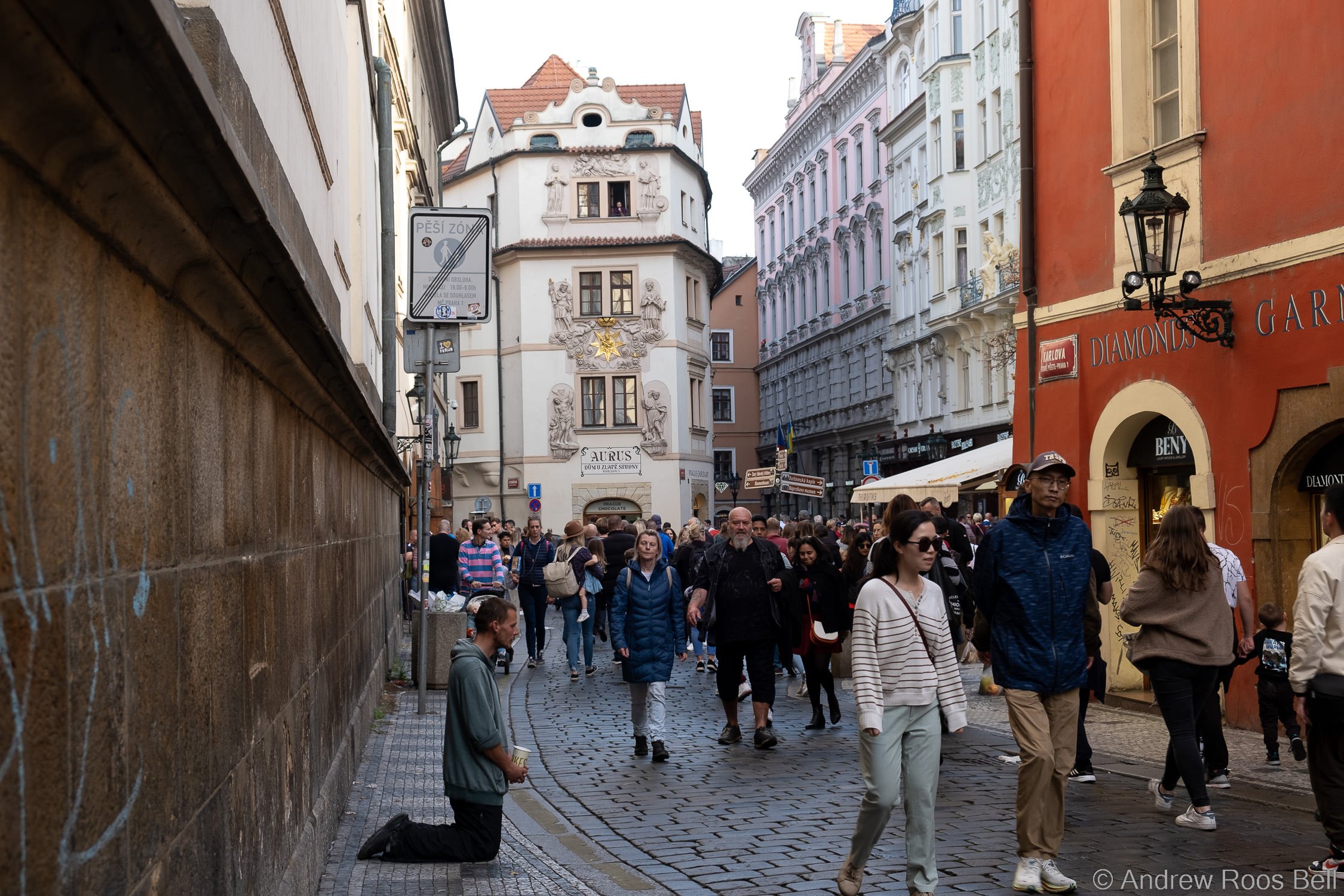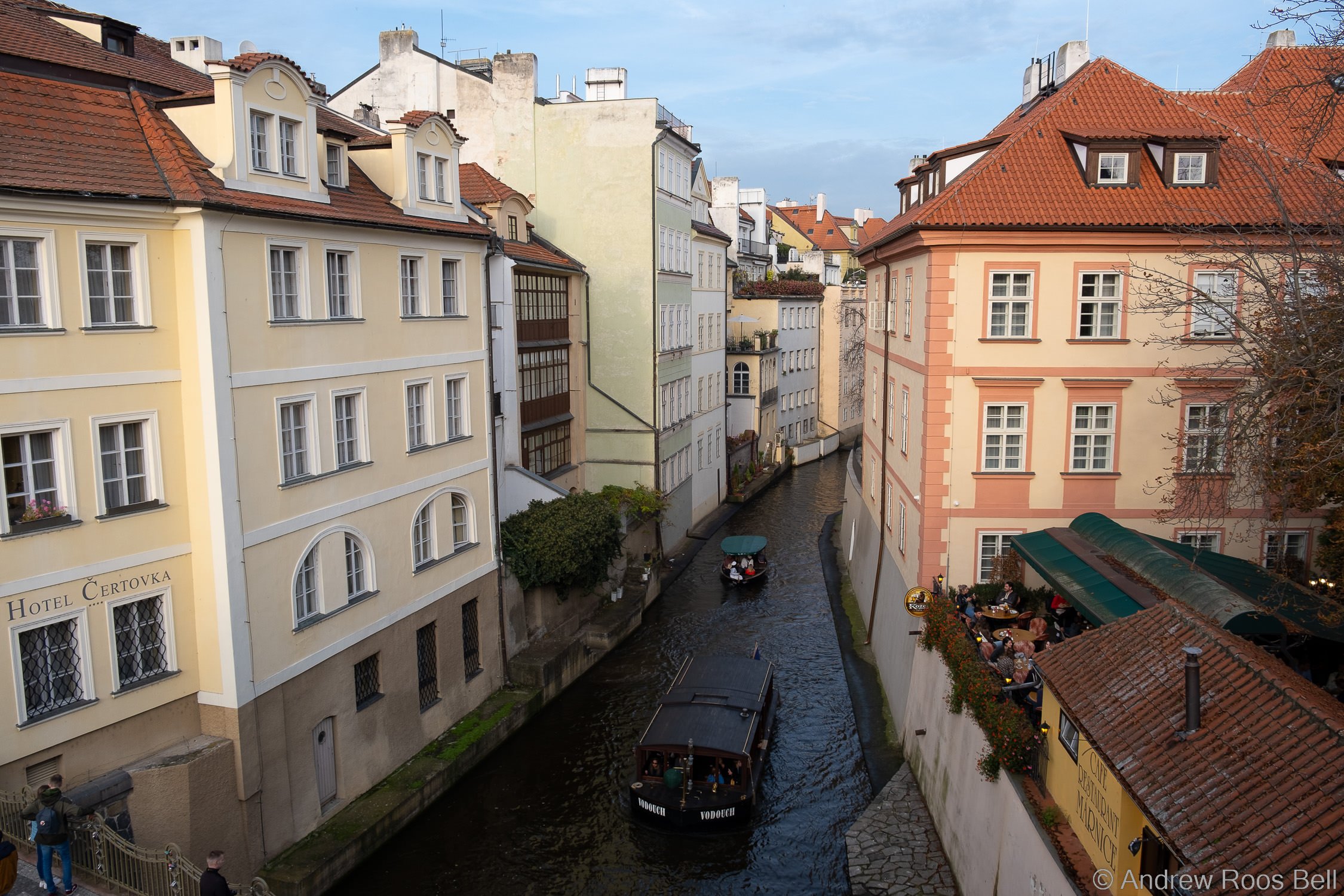Prague
From sepulchral Terezin I took the train south to vivacious capital of the Czech Republic, one of the most celebrated European cities, Prague. The city spans a great bend in the Vltava river, a major tributary of the Elbe, and grew up around a high fortress overlooking a ford in the river. Now the city seems flooded with tourists and partiers from all over Europe. Its place on the river crossing befits its history; Prague has frequently straddled the line between west and east, forming at one time part of the eastern edge of the Holy Roman Empire, and at another sitting as the western edge of the Warsaw Pact. The Czech Republic is the westernmost Slavic nation, but most of its history has been spent under German rulers as the kingdom of Bohemia, surrounded by German lands on three sides. Unsurprisingly, there’s an eclectic and rich variety of architecture.
While Terezin was cool and grey, when I arrived in Prague the city was in its October glory. The waterfront along the Vltava was in an almost constant sort of sub-magic hour glow, the air visibly suffused with honeyed light. Holidayers paddled on the river or crowded restaurant patios as children played under the leaves now browning in the autumnal oven.
Walking north into the old town, the lanes narrowed and the architecture intensified its gothic fantasies; but at the street level, the facades gave way to an endless carousel of trinket shops, weed shops, and one place claiming to only probably have the best burgers and hotdogs in town. It was as if Times Square had been poured into a maze of medieval lanes, seeping through the closes like syrup.
For the first time I saw a beggar kneeling, perfectly still. I’m used to beggars and panhandlers, but to see someone kneeling in what must have been an incredibly uncomfortable position for who knows how long still shocked me.
Then I came suddenly to the greatest attraction at the center of Prague; the ancient King Charles (not the one you’re thinking of) Bridge, and found its cobbles packed to bursting with every other tourist who had beelined there just like me.
In the square adjoining the bridge, a church bore this legend, another reminder that I was drawing closer to the part of the world still under the Russian shadow.
After a brief pause, I plunged into the stream of people and swam across the bridge, a salmon forcing its way upstream. Besides the magnificent towers and glowing views up and down the river, the Charles Bridge is lined with a panoply of stone figures, an outdoor statuary free to anyone willing to brave the crowds.
From the bridge, the road climbs through ever statelier neighborhoods, past domed cathedrals, up a great flight of stairs, to the castle square high above the town.
The second day I was in Prague, I passed the headquarters of the Communist Party of Bohemia and Moravia, which I believe is the only still-active Communist Party in a former Warsaw Pact nation. They don’t seem terribly threatening now; they haven’t managed to secure a single seat in parliament.
There’s a lovely big square in the center of right-bank old Prague, just past the Powder Tower (above), which features the place where the protestant rebels were executed after the battle of White Mountain; those sympathetic to the cause of either Protestantism or Czech independence from Habsburg dominance regard them as martyrs. Nearby, surveying the crosses which mark their deaths, is a looming statue of the proto-protestant reformer Jan Hus.
At the north end of the old city is the Jewish Quarter, which once had one of the largest and most flourishing Jewish communities in Europe. I spent a good part of the day wandering between synagogues and cemeteries, and learning about all the ideas and creative work that was done in the face of immense obstacles, by people whom popular history has often reduced to passive unfortunates.
That evening was Sunday night, and I crossed the river to the North shore. Wanting to be with others with something in common, I visited a small missionary church where English served as the common tongue for people from all over the continent and world. Refreshed, I walked back through the soft night of rustling leaves. There is a temperature that obtains in the evenings in temperate countries in the fall that has somehow the crisp freshness of cool air but also the spreading warmth of a humid summer night: it is exactly correct.
The park on the northern bank overlooks the city from a cascading wall of staircases and trees, and at the summit is a grand pediment, which now holds what is almost certainly the largest metronome in the world. It upheld the largest monument to Stalin, which was dynamited during de-Stalinization, and today the metronome bears the legend that “in time, all things pass.”
On the last day I spent in Prague, I visited the great castle. On my way up the hill, I encountered yet another reminder of the spirit of resistance still vital in what was once Communist Europe. From the balustrade of the castle square, you can see a reminder of that – the looming Soviet communications tower, now an incongruously picturesque artefact for nostalgia.
The gem in Prague’s crown is the Cathedral of St. Vitus’, which contains, among others, the tombs of St. John Nepomunk, a priest killed for upholding the seal of confession, who was then heavily promoted as part of the counter-Reformation, and the tomb of Duke Vaclav I, or as you may know him, Good King Weceslaus. He holds his place in the great European tradition of Saint-Kings who are revered as both the temporal founders and spiritual patrons of their nations, and which accrete all sorts of legends. He was supposedly murdered by his brother, Boleslaus the Cruel, and I’ll let you guess why we don’t sing any songs about him.
The castle also contained a much older church, a narrow lane filled with the homes (tiny!) of various craftspeople, particularly goldsmiths, the Crown of Bohemia (which was unfortunately not for sale, apparently), and, of course, the Window of the Defenestration, from which the Habsburg’s officials were thrown in the Third Defenestration of Prague (yes I know). They fell seventy feet, and were either saved by the Virgin Mary or by a dung heap, depending on whether you ask Catholics or Protestants. At any rate they survived, and the defenestration went down as both a nationalist and a religious rebellion, and one of the key inciting incidents of the terrible Thirty Year’s War.
Finally, I returned to the city, slept, and in the morning, I took the train to the East.

























































